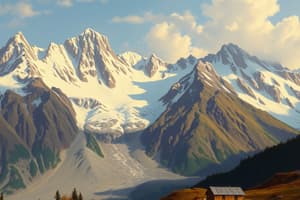Podcast
Questions and Answers
Which process caused continents to rebound after the last Ice Age?
Which process caused continents to rebound after the last Ice Age?
- Plate tectonics
- Volcanic activity
- Melting of ice caps (correct)
- Erosion
What caused the ground elevation to significantly lower on continents with ice caps?
What caused the ground elevation to significantly lower on continents with ice caps?
- Weight of the ice caps (correct)
- Earthquakes
- Plate collisions
- Volcanic eruptions
When did the last Ice Age end?
When did the last Ice Age end?
- 1,000 years ago
- 1 million years ago
- 100,000 years ago
- 10,000 years ago (correct)
Flashcards are hidden until you start studying
Study Notes
Post-Glacial Rebound
- Isostatic rebound is the process that caused continents to rebound after the last Ice Age, as the weight of the ice sheets was removed and the Earth's crust began to rise back up.
Ice Cap Formation and Ground Elevation
- The weight of the ice caps caused the ground elevation to significantly lower on continents with ice caps, resulting in a depression of the Earth's crust.
Timeline of the Last Ice Age
- The last Ice Age ended approximately 11,700 years ago, marking the beginning of the current geological epoch, the Holocene.
Studying That Suits You
Use AI to generate personalized quizzes and flashcards to suit your learning preferences.




